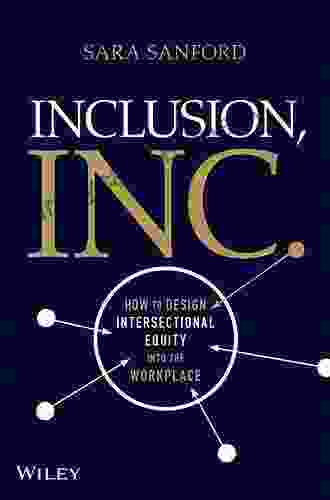Unlocking Equitable Workplaces: A Comprehensive Guide to Intersectional Equity

In today's rapidly evolving workforce, embracing diversity and fostering inclusivity is more critical than ever before. Recognizing the unique challenges and experiences faced by marginalized groups, "How to Design Intersectional Equity into the Workplace" emerges as an invaluable resource for organizations seeking to create truly equitable and inclusive environments.
Intersectional Equity: A Multi-faceted Approach
Intersectional equity acknowledges the complex interplay of factors such as race, gender, sexual orientation, socioeconomic status, and (dis)ability. It recognizes that individuals may experience discrimination not only based on a single characteristic but also on the intersection of multiple identities.
5 out of 5
| Language | : | English |
| Text-to-Speech | : | Enabled |
| Enhanced typesetting | : | Enabled |
| Word Wise | : | Enabled |
| Lending | : | Enabled |
| File size | : | 2280 KB |
| Screen Reader | : | Supported |
| Print length | : | 221 pages |
Key Principles for Equitable Workplaces
This comprehensive guide lays out the fundamental principles for designing workplaces that are truly intersectional:
- Center the experiences of marginalized groups: Engage with employees from diverse backgrounds to understand their unique perspectives and challenges.
- Examine existing systems and policies: Analyze current practices to identify and address any biases or barriers that may hinder equity.
- Establish clear goals and metrics: Outline specific objectives for increasing intersectional equity and establish metrics to track progress.
- Foster inclusive leadership: Empower leaders at all levels to champion diversity and create a culture of belonging.
- Provide ongoing training and development: Equip employees with the knowledge and skills necessary to recognize and challenge inequity.
Practical Strategies for Implementation
Beyond theory, the book provides practical strategies for implementing intersectional equity into various aspects of the workplace:
Recruitment and Hiring
- Use inclusive job descriptions and outreach strategies.
- Blind resume screening to minimize bias.
- Implement structured interview processes to ensure fairness.
Compensation and Benefits
- Conduct pay audits to identify and address wage gaps.
- Offer flexible work arrangements to accommodate diverse needs.
- Provide equitable access to training and development opportunities.
Workplace Culture
- Foster employee resource groups (ERGs) that support specific identity groups.
- Promote open dialogue and respectful communication.
- Establish a zero-tolerance policy for discrimination and harassment.
Leadership and Management
- Provide diversity and inclusion training for managers.
- Hold leaders accountable for creating inclusive environments.
- Encourage mentorship and sponsorship programs for underrepresented employees.
Impact of Intersectional Equity
Creating intersectional equity in the workplace has profound benefits for both organizations and employees:
- Improved performance: Diverse and inclusive teams drive innovation and enhance problem-solving.
- Enhanced employee satisfaction: Employees who feel valued and respected are more engaged and productive.
- Stronger brand reputation: Organizations that prioritize equity demonstrate their commitment to social responsibility.
- Reduced legal liability: Proactively addressing inequity mitigates legal risks associated with discrimination.
"How to Design Intersectional Equity into the Workplace" is an essential resource for any organization seeking to create a truly equitable and inclusive environment. By embracing the principles and implementing the strategies outlined in this book, organizations can unlock the transformative power of intersectional equity, fostering workplaces where all employees can thrive.
With its practical insights and actionable guidance, this book empowers organizations to transform their workplaces into beacons of diversity, inclusion, and belonging.
5 out of 5
| Language | : | English |
| Text-to-Speech | : | Enabled |
| Enhanced typesetting | : | Enabled |
| Word Wise | : | Enabled |
| Lending | : | Enabled |
| File size | : | 2280 KB |
| Screen Reader | : | Supported |
| Print length | : | 221 pages |
Do you want to contribute by writing guest posts on this blog?
Please contact us and send us a resume of previous articles that you have written.
 Book
Book Novel
Novel Page
Page Chapter
Chapter Text
Text Story
Story Genre
Genre Reader
Reader Library
Library Paperback
Paperback E-book
E-book Magazine
Magazine Newspaper
Newspaper Paragraph
Paragraph Sentence
Sentence Bookmark
Bookmark Shelf
Shelf Glossary
Glossary Bibliography
Bibliography Foreword
Foreword Preface
Preface Synopsis
Synopsis Annotation
Annotation Footnote
Footnote Manuscript
Manuscript Scroll
Scroll Codex
Codex Tome
Tome Bestseller
Bestseller Classics
Classics Library card
Library card Narrative
Narrative Biography
Biography Autobiography
Autobiography Memoir
Memoir Reference
Reference Encyclopedia
Encyclopedia Jenny Jones
Jenny Jones Bill Cotter
Bill Cotter Stuart Stevens
Stuart Stevens Bill Crawford
Bill Crawford Beth Miller
Beth Miller Belle Payton
Belle Payton Rand Fishkin
Rand Fishkin Bella Brownley
Bella Brownley Tara Neilson
Tara Neilson Bo Wu
Bo Wu Dean A Kowalski
Dean A Kowalski Benjamin Douglas
Benjamin Douglas Ben Rhodes
Ben Rhodes Lindsay Ellis
Lindsay Ellis Ben Mezrich
Ben Mezrich Betsy Whyte
Betsy Whyte Bob Hazard
Bob Hazard Bernadette Mcdonald
Bernadette Mcdonald Kazim Ali
Kazim Ali Howard Garrett
Howard Garrett
Light bulbAdvertise smarter! Our strategic ad space ensures maximum exposure. Reserve your spot today!
 Richard AdamsFollow ·6.5k
Richard AdamsFollow ·6.5k Johnny TurnerFollow ·5.8k
Johnny TurnerFollow ·5.8k Elias MitchellFollow ·15.5k
Elias MitchellFollow ·15.5k Russell MitchellFollow ·16.9k
Russell MitchellFollow ·16.9k Demetrius CarterFollow ·17.3k
Demetrius CarterFollow ·17.3k Alex FosterFollow ·18.3k
Alex FosterFollow ·18.3k Corey HayesFollow ·15.9k
Corey HayesFollow ·15.9k Todd TurnerFollow ·3.8k
Todd TurnerFollow ·3.8k

 Ivan Cox
Ivan CoxSpeak With Ease: The Ultimate Guide to Public Speaking...
By Rupika Raj ...

 Jesus Mitchell
Jesus MitchellVulcan Forge: A Suspense Thriller that Will Keep You on...
Vulcan Forge is...

 Dashawn Hayes
Dashawn HayesThe Carteret Family Bob Martin: A Comprehensive Review
Bob Martin's...

 Owen Simmons
Owen SimmonsUnlock the World of Cultural Nuances with "The Global...
Embark on a Journey of...

 Ian McEwan
Ian McEwanConquer the Mountain: True Account of Catastrophe and...
In the heart of California's stunning...
5 out of 5
| Language | : | English |
| Text-to-Speech | : | Enabled |
| Enhanced typesetting | : | Enabled |
| Word Wise | : | Enabled |
| Lending | : | Enabled |
| File size | : | 2280 KB |
| Screen Reader | : | Supported |
| Print length | : | 221 pages |














